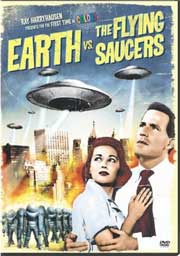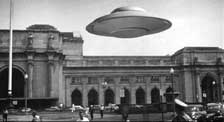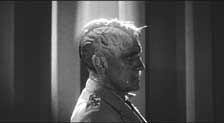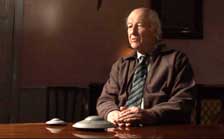 EARTH
VS. THE FLYING SAUCERS (1956)
EARTH
VS. THE FLYING SAUCERS (1956)Director: Fred F. Sears
Sony Pictures
 EARTH
VS. THE FLYING SAUCERS (1956)
EARTH
VS. THE FLYING SAUCERS (1956)For their second collaboration made for Columbia Studios (the first being IT CAME FROM BENEATH THE SEA), producer Charles H. Schneer and technical effects artist Ray Harryhausen took on the topical subject of Earth-bound invaders from another world. Although executive producer Sam Katzman was primarily known for his “B” level programmers, the resulting film, EARTH VS THE FLYING SAUCERS, remains one of the better alien invasion films of the 1950s, despite its miniscule budget. Previously released on DVD in 2002, Sony now revisits this popular title with the two-disc special treatment.

As head of Operation Skyhook, Dr. Russell Marvin (Hugh Marlowe) launches satellites into orbit, observing the atmosphere for future space flights. These satellites all fall back to Earth, blasted down by an unidentifiable force. Trying to solve the puzzle, Russell and his assistant/new bride Carol (Joan Taylor) witness a flying saucer speeding over their automobile and they soon realize who the culprit is. When one of the twirling crafts lands at a nearby military base, the soldiers that fire at it are quickly evaporated by laser beams and Carol’s father, General Hanley (Morris Ankrum), is abducted. A garbled message from the strange visitors is later slowed down and made comprehensible, but any seemingly diplomatic requests that they made were a trick: these are destructive beings from a dying planet, now bent on taking over the human race.
 With
the usual mass hysteria associated with 1950s alien invasion films on hand,
EARTH VS. THE FLYING SAUCERS is and always will be entertaining Saturday afternoon
fodder, highlighted by Harryhausen’s innovative special effects. Instead
of the usual mythical monsters, prehistoric creatures or oversized gorillas,
Harryhausen had to bring to life soaring vehicles of mass destruction, and he
does so with his usual magic and ingenuity. His frantically spinning saucers
are a sight to behold, especially when slicing through various Washington D.C.
landmarks such as the Capital Building during the film’s thrilling climax.
The aliens themselves are seen sporting clumsy, stiff but thin-coated armor,
topped off with a solid round helmet – this is all supposed to not only
protect them but magnify their senses. When the head gear of one of them is
removed, the creature is revealed to be a very creepy-looking humanoid. Another
cool effect is when human prisoners are brought upon the ship and brainwashed
with an energy beam, revealing their brain through the skull (we most likely
witness this since Curt Siodmak was responsible for the “screen story”).
With
the usual mass hysteria associated with 1950s alien invasion films on hand,
EARTH VS. THE FLYING SAUCERS is and always will be entertaining Saturday afternoon
fodder, highlighted by Harryhausen’s innovative special effects. Instead
of the usual mythical monsters, prehistoric creatures or oversized gorillas,
Harryhausen had to bring to life soaring vehicles of mass destruction, and he
does so with his usual magic and ingenuity. His frantically spinning saucers
are a sight to behold, especially when slicing through various Washington D.C.
landmarks such as the Capital Building during the film’s thrilling climax.
The aliens themselves are seen sporting clumsy, stiff but thin-coated armor,
topped off with a solid round helmet – this is all supposed to not only
protect them but magnify their senses. When the head gear of one of them is
removed, the creature is revealed to be a very creepy-looking humanoid. Another
cool effect is when human prisoners are brought upon the ship and brainwashed
with an energy beam, revealing their brain through the skull (we most likely
witness this since Curt Siodmak was responsible for the “screen story”).

Providing the vocals of the alien race is none other than Paul Frees, one of the most recognizable voice artists of all time. Despite being a bit campy, Frees conveys a intonation that’s distorted and somewhat threatening, and his presence makes it all the more fun. Since the two lead characters are introduced as just being married, there’s no time wasted on budding romances (something that surely drove 1950s juvenile theater goers nuts) and Hugh Marlowe and Joan Taylor play it straight and believable. Marlowe starred in Allied Artists’ WORLD WITHOUT END the same year, and Taylor would appear the following year in the next Harryhausen/Schneer vehicle, 20 MILLION MILES TO EARTH. As General Hanley, Morris Ankrum appeared in so many sci-fi flicks representing the military that he must have slept in a decorated uniform. Also appearing in the cast of familiar faces are Donald Curtis, Harry Lauter (both appeared in IT CAME FROM BENEATH THE SEA the previous year), John Zaremba (FRANKENSTEIN’S DAUGHTER) and Thomas Browne Henry (BLOOD OF DRACULA).
 Sony’s
new DVD of EARTH VS. THE FLYING SAUCERS presents the film in its original 1.85:1
aspect ratio with anamorphic enhancement. The black and white image is sharp
and very pleasing, with a great level of detail and deep black textures. Fine
grain is present but never a visual problem, and the image only becomes inferior
when stock footage is showcased. The film has been cleaned up a great deal since
the 2002 disc, removing virtually all the dirt, speckling and scratches present
in that previous release, making the upgrade all the more worth it. The computer
colorized version is there for those who want to toggle back and forth between
the two, and in some scenes it actually appears as if it was shot in color,
though in others, not so much. The English audio is presented in original mono
and 5.1 tracks (both sound quite good, with no distortions, but the mono is
preferable), as well as Portuguese, French and Spanish language tracks. Optional
English, Portuguese, French and Spanish subtitles are included.
Sony’s
new DVD of EARTH VS. THE FLYING SAUCERS presents the film in its original 1.85:1
aspect ratio with anamorphic enhancement. The black and white image is sharp
and very pleasing, with a great level of detail and deep black textures. Fine
grain is present but never a visual problem, and the image only becomes inferior
when stock footage is showcased. The film has been cleaned up a great deal since
the 2002 disc, removing virtually all the dirt, speckling and scratches present
in that previous release, making the upgrade all the more worth it. The computer
colorized version is there for those who want to toggle back and forth between
the two, and in some scenes it actually appears as if it was shot in color,
though in others, not so much. The English audio is presented in original mono
and 5.1 tracks (both sound quite good, with no distortions, but the mono is
preferable), as well as Portuguese, French and Spanish language tracks. Optional
English, Portuguese, French and Spanish subtitles are included.
 Disc
One features an audio commentary with Harryhausen, effects artists Jeff Okun
and Ken Ralston, and DVD producer Arnold Kunert. As with the other two titles
in this series, Harryhausen reveals a lot about the technical side, and the
participants seem to be having a lot of fun watching the film again, admittedly
favoring its antics over modern CGI-laden blockbusters. Disc 2 includes a few
featurettes carried over from Sony’s 20
MILLION MILES TO EARTH 50th Anniversary Special Edition; “Tim Burton
Sits Down with Ray Harryhausen”, “David Schechter on Film Music's
Unsung Hero,” “An Interview with Joan Taylor”, “The
Colorization Process” and a featurette with Arnold Kunert displaying the
various pressbooks, poster, lobby cards used to advertise Harryhausen’s
early Columbia films. “Ray Harryhausen on Earth vs. The Flying Saucers”
is a good 20-minute interview with the man, as he discusses the spaceship effects
and tells how pleased he is to have devoted fans from three generations. Footage
of Harryhausen greeting fans at a convention are shown, as are brief interview
clips from Stan Winston, Terry Gilliam and others. The screen credits for the
film, as originally seen, are also provided as an extra, listing the co-writer
as “Raymond T. Marcus” (this is actually a pseudonym for the blacklisted
Bernard Gordon, whose name has been seamlessly reinstated in the main feature).
The featurette called “The Hollywood Blacklist and Bernard Gordon”
is an interview with Del Reisman of the Writers Guild of America. Reisman explains
why Gordon and many other writers were blacklisted back in the 1950s, and tells
of the efforts that have been made to restore their proper screen credits. “A
Present Day Look at Stop Motion” has NYU film student Kyle Anderson demonstrating
puppet-making and the methods for animating them with modern technology. Rounding
out the extras is a massive photo gallery divided into three categories, and
a sneak peek at the comic book “Flying Saucers vs. the Earth.”
(George
R. Reis)
Disc
One features an audio commentary with Harryhausen, effects artists Jeff Okun
and Ken Ralston, and DVD producer Arnold Kunert. As with the other two titles
in this series, Harryhausen reveals a lot about the technical side, and the
participants seem to be having a lot of fun watching the film again, admittedly
favoring its antics over modern CGI-laden blockbusters. Disc 2 includes a few
featurettes carried over from Sony’s 20
MILLION MILES TO EARTH 50th Anniversary Special Edition; “Tim Burton
Sits Down with Ray Harryhausen”, “David Schechter on Film Music's
Unsung Hero,” “An Interview with Joan Taylor”, “The
Colorization Process” and a featurette with Arnold Kunert displaying the
various pressbooks, poster, lobby cards used to advertise Harryhausen’s
early Columbia films. “Ray Harryhausen on Earth vs. The Flying Saucers”
is a good 20-minute interview with the man, as he discusses the spaceship effects
and tells how pleased he is to have devoted fans from three generations. Footage
of Harryhausen greeting fans at a convention are shown, as are brief interview
clips from Stan Winston, Terry Gilliam and others. The screen credits for the
film, as originally seen, are also provided as an extra, listing the co-writer
as “Raymond T. Marcus” (this is actually a pseudonym for the blacklisted
Bernard Gordon, whose name has been seamlessly reinstated in the main feature).
The featurette called “The Hollywood Blacklist and Bernard Gordon”
is an interview with Del Reisman of the Writers Guild of America. Reisman explains
why Gordon and many other writers were blacklisted back in the 1950s, and tells
of the efforts that have been made to restore their proper screen credits. “A
Present Day Look at Stop Motion” has NYU film student Kyle Anderson demonstrating
puppet-making and the methods for animating them with modern technology. Rounding
out the extras is a massive photo gallery divided into three categories, and
a sneak peek at the comic book “Flying Saucers vs. the Earth.”
(George
R. Reis)